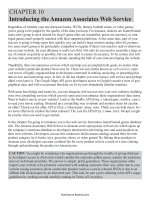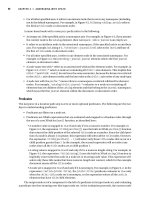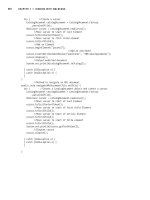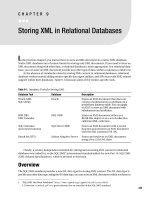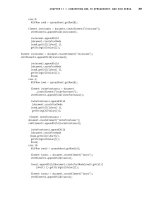railsspace building a social networking website with ruby on rails phần 8 pps
Bạn đang xem bản rút gọn của tài liệu. Xem và tải ngay bản đầy đủ của tài liệu tại đây (1.39 MB, 57 trang )
12.2 Manipulating avatars 377
eventual system call to the underlying convert executable will look something like
this:
system("#{convert} ")
The appropriate value of convert (with full path name) will automatically be interpo-
lated into the string used for the system call.
12.2.2 The save method
Now that we know how to convert images, we come finally to the Avatar save method.
save itself is somewhat of an anticlimax, since we push the hard work into an auxiliary
function called
successful_conversion?:
Listing 12.13 app/models/avatar.rb
class Avatar < ActiveRecord::Base
# Image sizes
IMG_SIZE = '"240x300>"'
THUMB_SIZE = '"50x64>"'
.
.
.
# Save the avatar images.
def save
successful_conversion?
end
private
.
.
.
# Try to resize image file and convert to PNG.
# We use ImageMagick's convert command to ensure sensible image sizes.
def successful_conversion?
# Prepare the filenames for the conversion.
source = File.join("tmp", "#{@user.screen_name}_full_size")
full_size = File.join(DIRECTORY, filename)
thumbnail = File.join(DIRECTORY, thumbnail_name)
# Ensure that small and large images both work by writing to a normal file.
# (Small files show up as StringIO, larger ones as Tempfiles.)
File.open(source, "wb") { |f| f.write(@image.read) }
# Convert the files.
system("#{convert} #{source} -resize #{IMG_SIZE} #{full_size}")
system("#{convert} #{source} -resize #{THUMB_SIZE} #{thumbnail}")
File.delete(source) if File.exists?(source)
# No error-checking yet!
return true
end
Simpo PDF Merge and Split Unregistered Version -
378 Chapter 12: Avatars
successful_conversion? looks rather long, but it’s mostly simple. We first define
file names for the image source, full-size avatar, and thumbnail, and then we use the
system command and our convert method to create the avatar images. We don’t need
to create the avatar files explicitly, since
convert does that for us. At the end of the
function, we return
true, indicating success, thereby following the same convention as
Active Record’s
save. This is bogus, of course, since the conversion may very well have
failed; in Section 12.2.3 we’ll make sure that
successful_conversion? lives up to its
name by returning the failure status of the system command.
The only tricky part of
successful_conversion? touches on a question we haven’t
yet answered: What exactly is an “image” in the context of a Rails upload? One might
expect that it would be a Ruby
File object, but it isn’t; it turns out that uploaded
images are one of two slightly more exotic Ruby types:
StringIO (string input-output)
for images smaller than around 15K and
Tempfile (temporary file) for larger images.
In order to handle both types, we include the line
File.open(source, "wb") { |f| f.write(@image.read) }
to write out an ordinary file so that convert can do its business.
10
File.open opens a
file in a particular mode—
"wb" for “write binary” in this case—and takes in a block in
which we write the image contents to the file using
@image.read. (After the conversion,
we clean up by deleting the source file with
File.delete.)
The aim of the next section is to add validations, but
save already works as long as
nothing goes wrong. By browsing over to an image file (Figure 12.3), we can update the
hub with an avatar image of our choosing (Figure 12.4).
12.2.3 Adding validations
You may have been wondering why we bothered to make the Avatar model a subclass
of
ActiveRecord::Base. The answer is that we wanted access to the error handling
and validation machinery provided by Active Record. There’s probably a way to add this
functionality without subclassing Active Record’s base class, but it would be too clever by
half, probably only serving to confuse readers of our code (including ourselves). In any
case, we have elected to use Active Record and its associated
error object to implement
validation-style error-checking for the Avatar model.
10
convert can actually work with tempfiles, but not with StringIO objects. Writing to a file in either case
allows us to handle conversion in a unified way.
Simpo PDF Merge and Split Unregistered Version -
12.2 Manipulating avatars 379
Figure 12.3 Browsing for an avatar image.
The first step is to add a small error check to the successful_conversion? func-
tion. By convention, system calls return
false on failure and true on success, so we
can test for a failed conversion as follows:
Listing 12.14 app/models/avatar.rb
def successful_conversion?
.
.
.
# Convert the files.
img = system("#{convert} #{source} -resize #{IMG_SIZE} #{full_size}")
thumb = system("#{convert} #{source} -resize #{THUMB_SIZE} #{thumbnail}")
File.delete(source) if File.exists?(source)
# Both conversions must succeed, else it's an error.
unless img and thumb
errors.add_to_base("File upload failed. Try a different image?")
return false
end
return true
end
Note that we have to use the return keyword so that the function returns immediately
upon encountering an error. Also note that we’ve used
errors.add_to_base
Simpo PDF Merge and Split Unregistered Version -
380 Chapter 12: Avatars
Figure 12.4 The user hub after a successful avatar upload.
rather than simply errors.add as we have before, which allows us to add an error
message not associated with a particular attribute. In other words,
errors.add(:image, "totally doesn't work")
gives the error message “Image totally doesn’t work”, but to get an error message like
“There’s no freaking way that worked” we’d have to use
errors.add_to_base("There's no freaking way that worked")
This validation alone is probably sufficient, since any invalid upload would trigger
a failed conversion, but the error messages wouldn’t be very friendly or specific. Let’s
explicitly check for an empty upload field (probably a common mistake), and also make
sure that the uploaded file is an image that doesn’t exceed some maximum threshold
Simpo PDF Merge and Split Unregistered Version -
12.2 Manipulating avatars 381
(so that we don’t try to convert some gargantuan multigigabyte file). We’ll put these
validations in a new function called
valid_file?, and then call it from save:
Listing 12.15 app/models/avatar.rb
# Save the avatar images.
def save
valid_file? and successful_conversion?
end
private
.
.
.
# Return true for a valid, nonempty image file.
def valid_file?
# The upload should be nonempty.
if @image.size.zero?
errors.add_to_base("Please enter an image filename")
return false
end
unless @image.content_type =~ /^image/
errors.add(:image, "is not a recognized format")
return false
end
if @image.size > 1.megabyte
errors.add(:image, "can't be bigger than 1 megabyte")
return false
end
return true
end
end
Here we’ve made use of the size and content_type attributes of uploaded images to
test for blank or nonimage files.
11
We’ve also used the remarkable syntax
if @image.size > 1.megabyte
Does Rails really let you write 1.megabyte for one megabyte? Rails does.
11
The carat ^ at the beginning of the regular expression means “beginning of line,” thus the image content
type must begin with the string
"image".
Simpo PDF Merge and Split Unregistered Version -
382 Chapter 12: Avatars
Since we’ve simply reused Active Record’s own error-handling machinery, allwe need
to do to display error messages on the avatar upload page is to use
error_messages_for
as we have everywhere else in RailsSpace:
Listing 12.16 app/views/avatar/upload.rhtml
<h2>Avatar</h2>
<% form_tag("upload", :multipart => true) do %>
<fieldset>
<legend><%= @title %></legend>
<%= error_messages_for 'avatar' %>
.
.
.
<% end %>
Now when we submit (for example) a file with the wrong type, we get a sensible error
message (Figure 12.5).
12.2.4 Deleting avatars
The last bit of avatar functionality we want is the ability to delete avatars. We’ll start by
adding a delete link to the upload page (which is a sensible place to put it since that’s
where we end up if we click “edit” on the user hub):
Listing 12.17 app/views/avatar/upload.rhtml
.
.
.
<%= avatar_tag(@user) %>
[<%= link_to "delete", { :action => "delete" },
:confirm => "Are you sure?" %>]
.
.
.
We’ve added a simple confirmation step using the :confirm option to link_to.
With the string argument as shown, Rails inserts the following bit of JavaScript into
the link:
[<a href="/avatar/delete" onclick="return confirm('Are you sure?');">delete</a>]
Simpo PDF Merge and Split Unregistered Version -
12.2 Manipulating avatars 383
Figure 12.5 The error message for an invalid image type.
This uses the native JavaScript function confirm to verify the delete request
(Figure 12.6). Of course, this won’t work if the user has JavaScript disabled; in that
case the request will immediately go through to the
delete action, thereby destroying
the avatar. C’est la vie.
As you might expect, the
delete action is very simple:
Listing 12.18 app/controllers/avatar controller.rb
.
.
.
# Delete the avatar.
def delete
user = User.find(session[:user_id])
user.avatar.delete
flash[:notice] = "Your avatar has been deleted."
Continues
Simpo PDF Merge and Split Unregistered Version -
384 Chapter 12: Avatars
Figure 12.6 Confirming avatar deletion with JavaScript.
redirect_to hub_url
end
end
This just hands the hard work off to the delete method, which we have to add to the
Avatar model. The
delete method simply uses File.delete to remove both the main
avatar and the thumbnail from the filesystem:
Listing 12.19 app/models/avatar.rb
.
.
.
# Remove the avatar from the filesystem.
Simpo PDF Merge and Split Unregistered Version -
12.2 Manipulating avatars 385
def delete
[filename, thumbnail_name].each do |name|
image = "#{DIRECTORY}/#{name}"
File.delete(image) if File.exists?(image)
end
end
private
.
.
.
Before deleting each image, we check to make sure that the file exists; we don’t want
to raise an error by trying to delete a nonexistent file if the user happens to hit the
/avatar/delete action before creating an avatar.
12.2.5 Testing Avatars
Writing tests for avatars poses some unique challenges. Following our usual practice
post-Chapter 5, we’re not going to include a full test suite, but will rather highlight a
particularly instructive test—in this case, a test of the avatar upload page (including the
delete action).
Before even starting, we have a problem to deal with. All our previous tests have
written to a test database, which automatically avoid conflicts with the development
and production databases. In contrast, since avatars exist in the filesystem, we have to
come up with a way to avoid accidentally overwriting or deleting files in our main avatar
directory. Rails comes with a temporary directory called
tmp, so let’s tell the Avatar
model to use that directory when creating avatar objects in test mode:
Listing 12.20 app/models/avatar.rb
class Avatar < ActiveRecord::Base
.
.
.
# Image directories
if ENV["RAILS_ENV"] == "test"
URL_STUB = DIRECTORY = "tmp"
else
URL_STUB = "/images/avatars"
Continues
Simpo PDF Merge and Split Unregistered Version -
386 Chapter 12: Avatars
DIRECTORY = File.join("public", "images", "avatars")
end
.
.
.
This avoids clashes with any files that might exist in public/images/avatars.
Our next task, which is considerably more difficult than the previous one, is to
simulate uploaded files in the context of a test. Previous tests of forms have involved
posting information like this:
post :login, :user => { :screen_name => user.screen_name,
:password => user.password }
What we want for an avatar test is something like
post :upload, :avatar => { :image => image }
But how do we make an image suitable for posting?
The answer is, it’s difficult, but not impossible. We found an answer on the Rails wiki
(
and have placed the resulting uploaded_file
function in the test helper:
Listing 12.21 app/test/test helper.rb
# Simulate an uploaded file.
# From />def uploaded_file(filename, content_type)
t = Tempfile.new(filename)
t.binmode
path = RAILS_ROOT + "/test/fixtures/" + filename
FileUtils.copy_file(path, t.path)
(class << t; self; end).class_eval do
alias local_path path
define_method(:original_filename) {filename}
define_method(:content_type) {content_type}
end
return t
end
We are aware that this function may look like deep black magic, but sometimes it’s
important to be able to use code that you don’t necessarily understand—and this is one
of those times. The bottom line is that the object returned by
uploaded_file can be
posted inside a test and acts like an uploaded image in that context.
Simpo PDF Merge and Split Unregistered Version -
12.2 Manipulating avatars 387
There’s only one more minor step: Copy rails.png to the fixtures directory so
that we have an image to test.
> cp public/images/rails.png test/fixtures/
Apart from the use of uploaded_file, the Avatar controller test is straightforward:
Listing 12.22 test/functional/avatar controller test.rb
require File.dirname(__FILE__) + '/ /test_helper'
require 'avatar_controller'
# Re-raise errors caught by the controller.
class AvatarController; def rescue_action(e) raise e end; end
class AvatarControllerTest < Test::Unit::TestCase
fixtures :users
def setup
@controller = AvatarController.new
@request = ActionController::TestRequest.new
@response = ActionController::TestResponse.new
@user = users(:valid_user)
end
def test_upload_and_delete
authorize @user
image = uploaded_file("rails.png", "image/png")
post :upload, :avatar => { :image => image }
assert_response :redirect
assert_redirected_to hub_url
assert_equal "Your avatar has been uploaded.", flash[:notice]
assert @user.avatar.exists?
post :delete
assert !@user.avatar.exists?
end
end
Here we’ve tested both avatar upload and deletion.
Running the test gives
> ruby test/functional/avatar_controller_test.rb
Loaded suite test/functional/avatar_controller_test
Started
.
Finished in 1.350276 seconds.
1 tests, 5 assertions, 0 failures, 0 errors
Simpo PDF Merge and Split Unregistered Version -
This page intentionally left blank
Simpo PDF Merge and Split Unregistered Version -
CHAPTER 13
In this chapter, we’ll learn how to send email using Rails, including configuration,
email templates, delivery methods, and tests. In the process, we’ll take an opportunity to
revisit the user login page in order to add a screen name/password reminder, which will
serve as our first concrete example of email. We’ll then proceed to develop a simple email
system to allow registered RailsSpace users to communicate with each other—an essential
component of any social network. We’ll see email again in Chapter 14, where it will
be a key component in the machinery for establishing friendships between RailsSpace
users.
13.1 Action Mailer
Sending email in Rails is easy with the Action Mailer package. Rails applies the MVC
architecture to email, with an Action Mailer class playing the part of model. Constructing
a message involves defining a method for that message—
reminder, for example—that
defines variables needed for a valid email message such as sender, recipient, and subject.
The text of the message is a view, defined in an rhtml file. Using the method and the
view, Action Mailer synthesizes a delivery function corresponding to the name of the
method (e.g.,
deliver_reminder for the reminder action), which can then be used
in a controller to send email based on user input.
The purpose of this section is to turn these abstract ideas into a concrete example by
configuring email and then implementing a screen name/password reminder.
389
Simpo PDF Merge and Split Unregistered Version -
390 Chapter 13: Email
13.1.1 Configuration
In order to send email, Action Mailer first has to be configured. The default configura-
tion uses SMTP (Simple Mail Transfer Protocol) to send messages, with customizable
server_settings:
1
Listing 13.1 config/environment.rb
# Include your application configuration below
.
.
.
ActionMailer::Base.delivery_method = :smtp
ActionMailer::Base.server_settings = {
:address => "smtp.example.com",
:port => 25,
:domain => "your_domain.com",
:authentication => :login,
:user_name => "your_user_name",
:password => "your_password",
}
You will need to edit the server settings to match your local environment, which will
probably involve using your ISP’s SMTP server. For example, to use DSLExtreme (an
ISP available in the Pasadena area), we could use the following:
Listing 13.2 config/environment.rb
# Include your application configuration below
.
.
.
ActionMailer::Base.delivery_method = :smtp
ActionMailer::Base.server_settings = {
:address => "smtp.dslextreme.com",
:port => 25,
:domain => "railsspace.com"
}
We’ve set up the domain parameter so that our messages will look like they come from
railsspace.com.
1
This is true in Rails1.2.1;asof Rails 1.2.2, server_settings has been deprecated in favor of smtp_settings.
Simpo PDF Merge and Split Unregistered Version -
13.1 Action Mailer 391
There’s one more small change to make: Since we will be sending email in the
development environment, we want to see errors if there are any problems with the mail
delivery. This involves editing the development-specific environment configuration file:
Listing 13.3 config/environments/development.rb
# Raise Errors if the mailer can't send
config.action_mailer.raise_delivery_errors = true
Once you make a change in this file, you need to restart your webserver. Your system
should then be ready to send email.
13.1.2 Password reminder
Currently, RailsSpace users who forget their screen names or passwords are out of luck.
Let’s rectify that situation by sending users a helpful reminder when supplied with a
valid email address. We’ll start by making a mailer for users. Unsurprisingly, Rails comes
with a script for generating them:
> ruby script/generate mailer UserMailer
exists app/models/
create app/views/user_mailer
exists test/unit/
create test/fixtures/user_mailer
create app/models/user_mailer.rb
create test/unit/user_mailer_test.rb
The resulting Action Mailer file, like generated Active Record files, is very simple, with
a new class that simply inherits from the relevant base class:
Listing 13.4 app/models/user mailer.rb
class UserMailer < ActionMailer::Base
end
Inside this class, we need to create a method for the reminder. As noted briefly
above, adding a
reminder method to the User mailer results in the automatic creation
of a
deliver_reminder function (attached to the UserMailer class). We will use this
function in the
remind action in Section 13.1.3. The reminder method itself is simply
a series of instance variable definitions:
Simpo PDF Merge and Split Unregistered Version -
392 Chapter 13: Email
Listing 13.5 app/models/user mailer.rb
class UserMailer < ActionMailer::Base
def reminder(user)
@subject = 'Your login information at RailsSpace.com'
@body = {}
# Give body access to the user information.
@body["user"] = user
@recipients = user.email
@from = 'RailsSpace <>'
end
end
Action Mailer uses the instance variables inside reminder to construct a valid email
message. Note in particular that elements in the
@body hash correspond to instance
variables in the corresponding view; in other words,
@body["user"] = user
gives rise to a variable called @user in the reminder view. In the present case, we use the
resulting
@user variable to insert the screen name and password information into the
reminder template:
Listing 13.6 app/views/user mailer/reminder.rhtml
Hello,
Your login information is:
Screen name: <%= @user.screen_name %>
Password: <%= @user.password %>
The RailsSpace team
Since this is just an rhtml file, we can use embedded Ruby as usual.
13.1.3 Linking and delivering the reminder
We’ve now laid the foundation for sending email reminders; we just need the infrastruc-
ture to actually send them. We’ll start by making a general Email controller to handle
the various email actions on RailsSpace, starting with a
remind action:
> ruby script/generate controller Email remind
exists app/controllers/
exists app/helpers/
Simpo PDF Merge and Split Unregistered Version -
13.1 Action Mailer 393
create app/views/email
exists test/functional/
create app/controllers/email_controller.rb
create test/functional/email_controller_test.rb
create app/helpers/email_helper.rb
create app/views/email/remind.rhtml
Next, we’ll add a reminder link to the login page (Figure 13.1):
Listing 13.7 app/views/user/login.rhtml
.
.
.
<p>
Forgot your screen name or password?
<%= link_to "Remind Me!", :controller => "email", :action => "remind" %>
</p>
<p>
Not a member? <%= link_to "Register now!", :action => "register" %>
</p>
Figure 13.1 The login page with screen name/password reminder.
Simpo PDF Merge and Split Unregistered Version -
394 Chapter 13: Email
The remind view is a simple form_for:
Listing 13.8 app/views/email/remind.rhtml
<% form_for :user do |form| %>
<fieldset>
<legend><%= @title %></legend>
<div class="form_row">
<label for="email">Email:</label>
<%= form.text_field :email, :size => User::EMAIL_SIZE %>
</div>
<div class="form_row">
<%= submit_tag "Email Me!", :class => "submit" %>
</div>
</fieldset>
<% end %>
Now set @title in the Email controller:
Listing 13.9 app/controllers/email controller.rb
class EmailController < ApplicationController
def remind
@title = "Mail me my login information"
end
end
With this, the remind form appears as in Figure 13.2.
Finally, we need to fill in the
remind action in the Email controller. Previously, in
the
login action, we used the verbose but convenient method
find_by_screen_name_and_password
In remind, we use the analogous find_by_email method:
Listing 13.10 app/controllers/email controller.rb
class EmailController < ApplicationController
def remind
@title = "Mail me my login information"
if param_posted?(:user)
Simpo PDF Merge and Split Unregistered Version -
13.1 Action Mailer 395
Figure 13.2 The email reminder form.
email = params[:user][:email]
user = User.find_by_email(email)
if user
UserMailer.deliver_reminder(user)
flash[:notice] = "Login information was sent."
redirect_to :action => "index", :controller => "site"
else
flash[:notice] = "There is no user with that email address."
end
end
end
end
The key novel feature here is the use of
UserMailer.deliver_reminder(user)
to send the message. Action Mailer passes the supplied user variable to the reminder
method and uses the result to construct a message, which it sends out using the SMTP
server defined in Section 13.1.1.
By default, Rails email messages get sent as plain text; see
/>for instructions on how to send HTML mail using Rails.
Simpo PDF Merge and Split Unregistered Version -
396 Chapter 13: Email
13.1.4 Testing the reminder
Writing unit and functional tests for mail involves some novel features, but before we
get to that, it’s a good idea to do a test by hand. Log in as Foo Bar and change the
email address to (one of) your own. After logging out, navigate to the password re-
minder via the login page and fill in your email address. The resulting reminder should
show up in your inbox within a few seconds; if it doesn’t, double-check the configu-
ration in
config/environment.rb to make sure that they correspond to your ISP’s
settings.
Even if you can’t get your system to send email, automated testing will still probably
work. Unit and functional tests don’t depend on the particulars of your configuration,
but rather depend on Rails being able to create UserMailer objects and simulate sending
mail. The unit test for the User mailer is fairly straightforward; we create (rather than
deliver) a UserMailer object and then check several of its attributes:
2
Listing 13.11 test/unit/user mailer test.rb
require File.dirname(__FILE__) + '/ /test_helper'
require 'user_mailer'
class UserMailerTest < Test::Unit::TestCase
fixtures :users
FIXTURES_PATH = File.dirname(__FILE__) + '/ /fixtures'
CHARSET = "utf-8"
include ActionMailer::Quoting
def setup
@user = users(:valid_user)
@expected = TMail::Mail.new
@expected.set_content_type "text", "plain", { "charset" => CHARSET }
end
def test_reminder
reminder = UserMailer.create_reminder(@user)
assert_equal '', reminder.from.first
assert_equal "Your login information at RailsSpace.com", reminder.subject
assert_equal @user.email, reminder.to.first
assert_match /Screen name: #{@user.screen_name}/, reminder.body
assert_match /Password: #{@user.password}/, reminder.body
end
2
Feel free to ignore the private functions in this test file; they are generated by Rails and are needed for the
tests, but you don’t have to understand them. Lord knows we don’t.
Simpo PDF Merge and Split Unregistered Version -
13.1 Action Mailer 397
private
def read_fixture(action)
IO.readlines("#{FIXTURES_PATH}/user_mailer/#{action}")
end
def encode(subject)
quoted_printable(subject, CHARSET)
end
end
The UserMailer.create_reminder method in the first line of test_reminder, like
the
deliver_reminder method from Section 13.1.3, is synthesized for us by Rails.
The resulting UserMailer object has attributes corresponding to the different fields in
an email message, such as
subject, to, and date, thereby allowing us to test those
attributes. Unfortunately, these are not, in general, the same as the variables created
in Section 13.1.2:
from comes from @from and subject comes from @subject, but
to comes from @recipients and date comes from @sent_on. These Action Mailer
attributes are poorly documented, but luckily you can guess them for the most part.
Let’s go through the assertions in
test_reminder.Weuse
reminder = UserMailer.create_reminder(@user)
to create a reminder variable whose attributes we can test. The to attribute,
reminder.to
is an array of recipients, so the first element is
reminder.to.first
which we test against @user.email. This test also introduces assert_match, which
verifies that a string matches a given regular expression—in this case, verifying that the
screen name and password lines appear in the reminder message body.
Running the test gives
3
> ruby test/unit/user_mailer_test.rb
Loaded suite test/unit/user_mailer_test
Started
.
Finished in 0.2634 seconds.
1 tests, 5 assertions, 0 failures, 0 errors
3
If you are running Rails 1.2.2 or later, you will get a DEPRECATION WARNING when you run the email tests.
To get rid of the warning, simply change
server_settings to smtp_settings in environment.rb.
Simpo PDF Merge and Split Unregistered Version -
398 Chapter 13: Email
The functional test for the password reminder is a little bit more complicated.
In particular, the setup requires more care. In test mode, Rails doesn’t deliver email
messages; instead, it appends the messages to an email delivery object called
@emails.
This list of emails has to be cleared after each test is run, because otherwise messages
would accumulate, potentially invalidating other tests.
4
We accomplish this with a call
to the
clear array method in the setup function:
Listing 13.12 test/functional/email controller test.rb
require File.dirname(__FILE__) + '/ /test_helper'
require 'email_controller'
# Re-raise errors caught by the controller.
class EmailController; def rescue_action(e) raise e end; end
class EmailControllerTest < Test::Unit::TestCase
fixtures :users
def setup
@controller = EmailController.new
@request = ActionController::TestRequest.new
@response = ActionController::TestResponse.new
@emails = ActionMailer::Base.deliveries
@emails.clear
@user = users(:valid_user)
# Make sure deliveries aren't actually made!
ActionMailer::Base.delivery_method = :test
end
.
.
.
We’ve added a line telling Rails that the delivery method is in test mode:
ActionMailer::Base.delivery_method = :test
This is supposed to happen automatically for tests, but on some systems we’ve found
that setting it explicitly is necessary to avoid actual mail delivery.
Since a successful email reminder should add a single message to
@emails, the test
checks that a message was “sent” by making sure that the length of the
@emails array
is 1:
4
With only one test, it doesn’t matter, but presumably we’ll be adding more tests later.
Simpo PDF Merge and Split Unregistered Version -
13.2 Double-blind email system 399
Listing 13.13 test/functional/email controller test.rb
.
.
.
def test_password_reminder
post :remind, :user => { :email => @user.email }
assert_response :redirect
assert_redirected_to :action => "index", :controller => "site"
assert_equal "Login information was sent.", flash[:notice]
assert_equal 1, @emails.length
end
end
Running the test gives
> ruby test/functional/email_controller_test.rb
Loaded suite test/functional/email_controller_test
Started
.
Finished in 0.179272 seconds.
1 tests, 4 assertions, 0 failures, 0 errors
13.2 Double-blind email system
In this section, we develop a minimalist email system to allow registered RailsSpace users
to communicate with each other. The system will be double-blind, keeping the email
address of both the sender and the recipient private. We’ll make an email form that
submits to a
correspond action in the Email controller, which will send the actual
message. In the body of the email we’ll include a link back to the same email form so
that it’s easy to reply to the original message.
5
13.2.1 Email link
We’ll get the email system started by putting a link to the soon-to-be-written corre-
spond
action on each user’s profile. Since there is a little bit of logic involved, we’ll wrap
up the details in a partial:
5
We really ought to allow users to respond using their regular email account; unfortunately, this would involve
setting up a mail server, which is beyond the scope of this book.
Simpo PDF Merge and Split Unregistered Version -
400 Chapter 13: Email
Listing 13.14 app/views/profile/ contact box.rhtml
<% if logged_in? and @user != @logged_in_user %>
<div class="sidebar_box">
<h2>
<span class="header">Actions</span>
<br clear="all" />
</h2>
<ul>
<li><%= link_to "Email this user",
:controller => "email", :action => "correspond",
:id => @user.screen_name %></li>
</ul>
</div>
<% end %>
We’ve put the link inside a list element tag in anticipation of having more contact
actions later (Section 14.2.1). Since it makes little sense to give users the option to email
themselves, we only show the sidebar box if the profile user is different from the logged-in
user. To get this to work, we need to define the
@logged_in_user instance variable in
the Profile controller’s
show action:
Listing 13.15 app/controllers/profile controller.rb
def show
@hide_edit_links = true
screen_name = params[:screen_name]
@user = User.find_by_screen_name(screen_name)
@logged_in_user = User.find(session[:user_id]) if logged_in?
if @user
.
.
.
end
All we have left is to invoke the partial from the profile:
Listing 13.16 app/views/profile/show.rhtml
<div id="left_column">
<%= render :partial => 'avatar/sidebar_box' %>
<%= render :partial => 'contact_box' %>
.
.
.
Simpo PDF Merge and Split Unregistered Version -
13.2 Double-blind email system 401
13.2.2 correspond and the email form
The target of the link in the previous section is the correspond action, which will also
be the target of the email form. The form itself will contain the two necessary aspects
of the message, the subject and body. In order to do some minimal error-checking on
each message, we’ll make a lightweight Message class based on Active Record, which has
attributes for the message subject and body:
Listing 13.17 app/models/message.rb
class Message < ActiveRecord::Base
attr_accessor :subject, :body
validates_presence_of :subject, :body
validates_length_of :subject, :maximum => DB_STRING_MAX_LENGTH
validates_length_of :body, :maximum => DB_TEXT_MAX_LENGTH
def initialize(params)
@subject = params[:subject]
@body = params[:body]
end
end
By overriding the initialize method, we avoid having to create a stub messages
table in the database.
6
Since only registered users can send messages, we first protect the correspond action
with a before filter. We then use the Message class to create a Message object, which we
can then validate by calling the message’s
valid? method:
Listing 13.18 app/controllers/email controller.rb
class EmailController < ApplicationController
include ProfileHelper
before_filter :protect, :only => [ "correspond" ]
.
.
.
def correspond
user = User.find(session[:user_id])
Continues
6
It’s annoying that we have to inherit from Active Record just to get validations and error-handling—those
functions don’t have anything specifically to do with databases. We’ve heard rumors about a proposed base class
called Active Model, which would serve as a parent class for all Active Record-like classes. Someday we hope to
be able to use Active Model instead of Active Record in cases such as this one.
Simpo PDF Merge and Split Unregistered Version -




